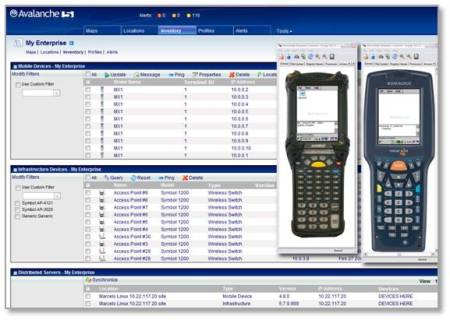Check out our new Mobile Ecosystem Blog at http://www.Wavelink.com/Blog. As of today, the http://www.wavelink.wordpress.com account will be moved to http://www.Wavelink.com/Blog. Please visit us there, and subscribe to our NEW Blog!
NEW BLOG – Please Update Your Information
May 1, 2012The Unsung Hero of Your Logistics Mobile Ecosystem: Remote Management
March 29, 2012For the average consumer, buying online doesn’t seem like a logistical nightmare; just click and buy, and a few days later it shows up at your house…most of the time. But behind the scenes there is a system set up to make sure everything is being accounted for, and the thought of something going wrong keeps managers up at night.
To put it in perspective, this past holiday season, Americans spent nearly $32 billion dollars online. The average package delivered by UPS took a ride on one of its more than 500 airplanes, traveled on 155 miles of conveyor belts and was scanned upwards of 23 times all before it got to your door.
To say this is a logistical nightmare is an understatement.
With more customers shopping online than ever before, it becomes increasingly important that a company’s mobile ecosystem is in order and that your company has a centralized management system to control those mobile devices.
In October 2011, FedEx estimated they would deliver 17 million packages in ONE day during the holiday season (December 12, the busiest delivery day of the year). What happens if one of those ruggedized scanners the driver uses malfunctions? If you aren’t able to remotely manage that device, it can cost a company thousands of dollars in lost productivity, not to mention the hit your brand takes.
With a well-thought out mobile strategy, an IT manager can remotely log-in to that device, diagnose the problem and get it back up and running, and let the driver get to their destination.
With that in mind, you can quickly see how remote management of ruggedized devices is the unsung hero of your logistics mobile ecosystem.
How are you managing your devices?
Healthcare, Healthcare, Healthcare – The Marcia Brady of the Mobility Space?
March 27, 2012Healthcare, healthcare, healthcare. It’s like the mobile industry’s own Marcia Brady these days, as more and more attention is being given to mHealth. Just yesterday, we posted an interesting article about what happens when doctors lose their smart devices. But, healthcare mobility issues go beyond losing devices and extends to much higher-level mobility strategy. In May 2010, Gartner’s John Lovelock stated that healthcare CIOs were lagging when it came to having a sound strategy for enterprise mobility in place. CIOs stated that they were hoping one mobile platform or OS would emerge for management purposes. While no single platform has emerged as the clear winner, things are changing when it comes to mobility in healthcare.
“Mobile is certainly still one [area of health IT] that needs to be on that list of what’s coming. It’s here, but it’s still coming. We are just seeing the beginning of that. This is going to be something that is going to become much more significant,” said HIMSS CEO H. Stephen Lieber in an interview with MobiHealthNews.
We’ve mentioned that there doesn’t seem to be one clear platform winner, but Apple’s iPad is really making a big case for its place in the healthcare mobile ecosystem. According to an article in Wired, the Veterans Administration is looking to deploy 100,000 iPads across 152 locations and with the announcement of the iPad 3, CIOs will need to assess where it fits within their mobile ecosystem. Once they assess where it fits in, the bigger question becomes, “How do we manage it?”
For obvious reasons, security is a big issue in the healthcare mobile ecosystem and management extends beyond the physical device. As the BYOD phenomenon spills over into the healthcare sector, employees want their own devices to have network access. While the iPad and other slick handheld products get most of the attention with healthcare mobility, CIOs can’t forget about the management of other endpoints that are in the ecosystem: printers, ruggedized handhelds, routers, access points, etc.
If you’re an IT professional in the healthcare field, are you mindful to buy and consider products that can manage multiple platforms and OSes? Do you think multiple platform management is important? We’d love to hear your opinion.
-BH
We’ve Added Another Mobile Device Manufacturer to the Wavelink Family!
March 22, 2012We’re exited to announce that we’ve added Casio to the Wavelink family of global partnerships! Casio’s DT-X8 hand-held terminal now comes preloaded with our Wavelink Avalanche, Wavelink Terminal Emulation and Wavelink Industrial Browser, making it easier than ever to quickly deploy these applications across an entire enterprise.
 The partnership simplifies the deployment and management of a mobile environment with Avalanche, while giving Casio DT-X8 customers the most widely used TE platform on the market.
The partnership simplifies the deployment and management of a mobile environment with Avalanche, while giving Casio DT-X8 customers the most widely used TE platform on the market.
Casio’s DT-X8 was released in 2011 and has been extremely successful. The ruggedized device is ideal for use in very tough applications where the rugged design is top priority. We’re proud that this extremely rugged hardware is now equipped with our equally rugged software applications for fast and easy deployment across the enterprise.
Welcome to the team!
In Depth Honeywell APAC Wrap-Up
March 20, 2012As you saw (click here for the pictures), the Wavelink AsiaPac team attended and sponsored the Honeywell AsiaPac and China shows on Feb 28-29, and Mar 1-2 respectively in Hangzhou China near Shanghai.
The conferences were to bring together Honeywell’s reseller and partners to learn Honeywell’s plans for 2012 and beyond. Products, strategies, and guidance on how to maximize your opportunities were provided in the areas of mobile computers and scanners. Participants were rotated through sessions specializing on field mobility, retail, and warehousing with each touching on how Honeywell specializes in each area, and how participants can again optimize their participation in these market segments.
Unwrapping the Retail Business Technology Expo
March 15, 2012The UK’s Retail Business Technology Expo came to a close in London yesterday.
In its second year there is no doubt that the event more than doubled in the number of exhibitors, space and sessions over last year. Aimed at UK and European retailers, the event melds all manner of end-to-end solutions for multi-channel, e-commerce, marketing, merchandising, EPoS, supply chain, store systems, loss prevention, finance, payments and CRM. Phew, that’s a lot of ground to cover!
The Warehouse’s Biggest Helper: Victor – Oscar – India – Charlie – Echo
March 13, 2012Last week, Multichannel Merchant had a great article that focused on how to improve warehouse productivity. He had nine tips for doing so ranging from creating a picking path to listening to employee feedback.
We’d like to add a tenth – using your voice.
Voice picking isn’t new to the warehouse. In fact, our voice picking product, Speakeasy, has been around for years, but just within the last couple of years companies have really started to implement it and see huge returns.
Take Goya Foods for example. They have been using Speakeasy in their Prince George facility. Within the first few months of using Speakeasy, they noticed improvement in three areas – accuracy, efficiency, and safety. Like Goya, most companies see the following:
Accuracy
Mispicks can lead to significant expenses, costing most companies anywhere from $5 – $50 per error. With that in mind, you can see how the savings quickly add up. (To see for yourself, contact us for a copy of our Speakeasy ROI Calculator)
Efficiency
On average, pick teams will complete their tasks much faster than before. With voice, pick teams move from sequence to sequence in rapid time.
Safety
With voice commands, pickers move from point to point more safely. This makes plant managers much more at ease.
Another thing to point out is that management costs of Speakeasy are minimal because the product is advanced enough that pickers don’t need to go through technical training to calibrate it for their own use.
Not to mention it is really easy to use, as our own Greg Berger demonstrates for Warehouse IQ at ProMat last year.
MDM Deliveries – Benefits of SaaS MDM Wrap-Up
March 7, 2012As many of you saw at our live webinar last Thursday, there are many factors that go into which MDM delivery method might best suit your organization. The traditional method of deployment requires that you, as an organization, provide a level of commitment to hosting your own service. This model has clear advantages in terms of providing complete control and may also suit legal and technical challenges that may exist. However, there is an alternative deployment option which still provides the equivalent high level of security, while at the same time offloading installation and maintenance tasks.
 By opting for a SaaS model, you’re better able to focus on your business of managing your devices without having to deal with operational issues. Those operational issues can often delay deployments, as the necessary infrastructure needs to be in place for the benefits to be realized. For companies that are new to device management, or for companies where the investment cannot be justified, at least initially, what sorts of operational benefits are included in your subscription?
By opting for a SaaS model, you’re better able to focus on your business of managing your devices without having to deal with operational issues. Those operational issues can often delay deployments, as the necessary infrastructure needs to be in place for the benefits to be realized. For companies that are new to device management, or for companies where the investment cannot be justified, at least initially, what sorts of operational benefits are included in your subscription?
Installation
- Sign up and go!
- All you need to think about is loading a client agent onto a device and enrolling the device into your segment of the cloud service.
Reliability
- Your SaaS provider hosts the service using hardware, connections and facilities that are highly resilient.
Scalability
- As you add more devices your subscription level automatically adjusts the resources needed to keep your devices up to date, monitored and secure. There’s never a need to perform any hardware or connection upgrades because you’ve grown.
Disaster Management
- Anyone that runs their own IT organizations knows the importance of having standby hardware and backup/restore capabilities in the event of the unforeseen. Again, the SaaS provider has these procedures already in place and has high-availability-by-design. And the best part is that you don’t even need to care about it. Your service just keeps on working, 24/7.
Financial Benefits
- Your commitment to a SaaS service has a fixed timeframe and you are able to grow your subscription as you need more management capabilities and as your revenue grows.
Of course, opting for a SaaS vendor which has both on-premise and a SaaS management offering which are based around a common technology, also makes it much easier should you decide to enroll into SaaS, or move operations into your own IT organization.
 The Wavelink SaaS product, Avalanche On Demand, provides customers with the same features and control that an on-site installation offers but with lower up-front costs complete with maintenance included in the subscription. Priority concerns such as security are also addressed by providing an encrypted path between your management console and Wavelink’s servers, as well as encrypted communications between each device and the Avalanche On Demand data centers.
The Wavelink SaaS product, Avalanche On Demand, provides customers with the same features and control that an on-site installation offers but with lower up-front costs complete with maintenance included in the subscription. Priority concerns such as security are also addressed by providing an encrypted path between your management console and Wavelink’s servers, as well as encrypted communications between each device and the Avalanche On Demand data centers.
Since Wavelink has adopted a full Web-based approach to both account control and device management, access couldn’t be simpler. The user-friendly console design streamlines device management tasks, making them as efficient as possible while providing rich reporting and status information about your managed estate.
Customers simply pay a monthly subscription fee for each mobile device they wish to manage. The fee covers standard maintenance and upgrades.
To see how Avalanche On Demand can benefit your organization click here to view the webinar in its entirety. What are some insights you might have towards the different delivery models? Have you been part of any discussions on the topic with colleagues or industry veterans?
-Martin Brewer
Site Seeing From Honeywell APAC Partner Conference
March 1, 2012Good afternoon! Quick post with some pictures for your Thursday afternoon.
Kelly Ungs, Steve Shea, and H’ng Cui Gin attended the Honeywell APAC Partner Conference earlier this week, and sent along some photos. As the need for mobility continues to boom in emerging markets such as China, device manufacturers such as Honeywell, are answering the call.
-BH




